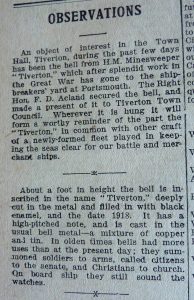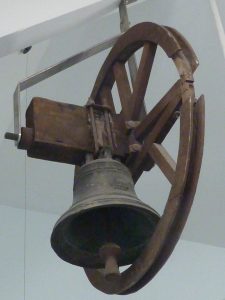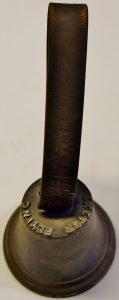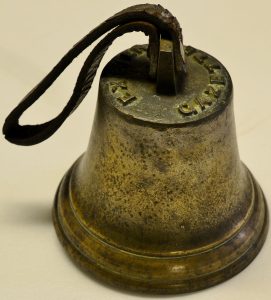In early March 1923 the following appeared in the Tiverton Gazette:

A close up of a newspaper article entitled ‘Observations’. The text reads ‘ An object of interest in the Town Hall, Tiverton, during the past few days has been the bell from the H.M Minesweeper ‘Tiverton’, which after splendid work in the Great War has gone to the shipbreakers’ yard at Portsmouth. The Right Hon. F. D. Acland secure the bell, and made a present of it to Tiverton Town Council. Wherever it is hung it will form a worthy reminder of the part the ‘Tiverton’, in common with other craft of a newly-formed fleet played in keeping the seas clear for our battle and merchant ships.
About a foot in height the bell is inscribed in the name ‘Tiverton’, deeply cut in the metal and filled in with black enamel, and the date 1918. it has a high pitched note, and is case in the usual bell metal – a mixture of copper and tin. in olden times bells had more uses than at the present date; they summoned soldiers to arms, called citizens to the senate, and Christians to church. On board ship the still sound the watches.’
Although she was sent to the shipbreakers yard, HMS Tiverton survived in various roles until being decommissioned and sold to a shipbreakers in 1938.
An image of the ship’s badge can be found here.

Ranging from the large bell used to call inmates of the Workhouse to order to very small hand bells, the Museum has a variety of bells. Come and see the largest hanging in one of the upstairs galleries. It was cast by John Packer who is listed as operating in Bristol between 1692 and 1705.
Smaller bells include one used at Tiverton Art School which show signs of having been rung electrically.


In the 19th century, before the advent of any mass media, the sale of newspapers was of great importance. In the large cities a morning and evening edition were often on sale. More locally, newspapers were sold on the streets and bells used to locate the seller. We have two of these bells and the publications names are clearly marked on top of the bell. Both of these Exeter based newspapers had slight variations in their titles during their long histories. The Exeter Flying Post was published between 1765 and 1917. The Exeter Gazette first appeared in 1792 and survived until 1952. 19th century editions of both of these newspapers are available on the website of the British Newspaper Archive.
Written by museum volunteer, Sue B.

